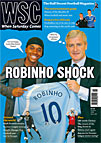 The long throw is back with a bang, as Rory Delap bamboozles Aston Villa. Glen Wilson champions this strong-arm tactic
The long throw is back with a bang, as Rory Delap bamboozles Aston Villa. Glen Wilson champions this strong-arm tactic
August 23, 2008, will be noted as the day that a traditional bastion of British football made a comeback, via an injury-time winning goal in the shadow of Sir Stanley Matthews’s statue. Yes, the long throw-in is back.
Rory Delap’s air-to-ground missile for Stoke against Aston Villa brought three points for his side and, more importantly, reintroduced the almost forgotten art of the long throw-in to the nation’s living rooms. Traditionalists such as John Arne Riise have hurled the odd ball straight into the box every now and again, but like terraces and 3pm Saturday kick-offs the long throw has slowly been vanishing from the top of the national game.
Though hated by that indeterminate bunch commonly known as “the purists”, the long throw is a proven and effective method of doing what the England midfield seem incapable of: namely getting the ball into areas that may lead to a goal being scored. Given that David Beckham remains a fixture in the England line-up for his ability to deliver “a quality ball in”, why has there been no comparable praise for the throw-in style of Delap?
Perhaps this foot-to-hand bias has its roots in the game’s history. To prevent 19th-century players from hurling the ball way downfield one-handed like an NFL quarter‑back, the FA changed the rules. In came the requirement that a throw required both hands to be placed behind the head with both feet on the floor. That seemed to be the end of the long throw as a potent weapon until the 1970 FA Cup final and the windmill technique pioneered by Chelsea’s Ian Hutchinson. He believed that by continuing the throw motion after the release the ball would be propelled even further, with his side’s winner in the final replay against Leeds providing some proof.
Twelve years later the long throw produced another Cup final assist from QPR’s Simon Stainrod, but it was not until the end of the century that the art reached its zenith. The long jump had Mike Powell versus Carl Lewis, the long throw had Cardiff’s Andy Legg versus Dave Challinor of Tranmere. The latter’s manager John Aldridge instructed all the Prenton Park ballboys to carry hand towels to dry the ball before giving it to Challinor. They also made gaps in the advertising hoarding to aid his run-up.
As with other aspects of the game, the long throw-in also had its showboaters, such as that footballing cavalier Steve Watson, who introduced the somersault technique, using a hand spring to gather more momentum. Stop-motion online footage of Watson in performance puts me in mind of the faux breakdancing seen on The Fresh Prince of Bel‑Air. It was believed that distances up to 70 metres could be achieved using this technique, as well as countless crooked necks and slipped discs on amateur football fields the length of the country.
In Ken Bray’s How to Score, the author suggests that a long throw should be easier to defend than a free-kick or corner as the ball is usually in the air for longer, giving defenders more time to react. And yet, despite the science, an effective long throw continues to make even the most talented defender look as composed as a cat that’s just fallen in a bath. Given its effectiveness, it may be that the long throw has come to be considered as a last resort due to the changing demands of football fandom. Many supporters are no longer happy with just a win – having forked out a considerable fortune for their ticket, they want instead to be entertained. Gary Neville’s long throw used to be a regular feature of Manchester United attacks, but now the ball has to be delivered to the feet of Cristiano Ronaldo for a stepover or seven.
While some players have been honed into free-kick specialists, the long throwers have been left to their own devices, with their speciality becoming the wind turbine on football’s coastline, functional and effective, yet commonly perceived as a blot on the landscape. However, I ask of you, please look again. When it’s late afternoon and you need that last-gasp equaliser at any cost, you may yet see that the long throw-in, like the well delivered free-kick, can become a thing of beauty.
From WSC 260 October 2008